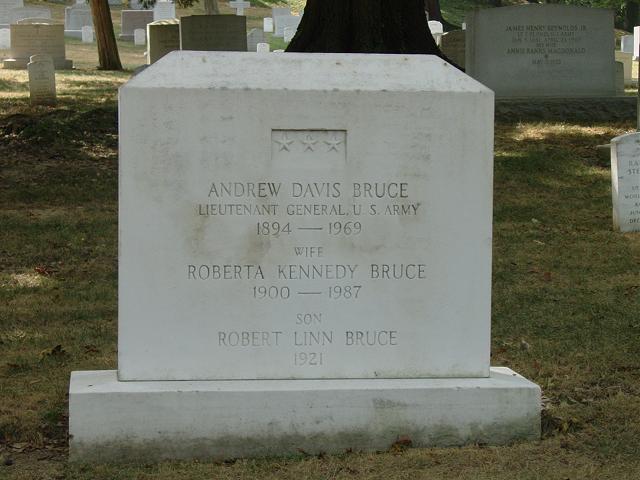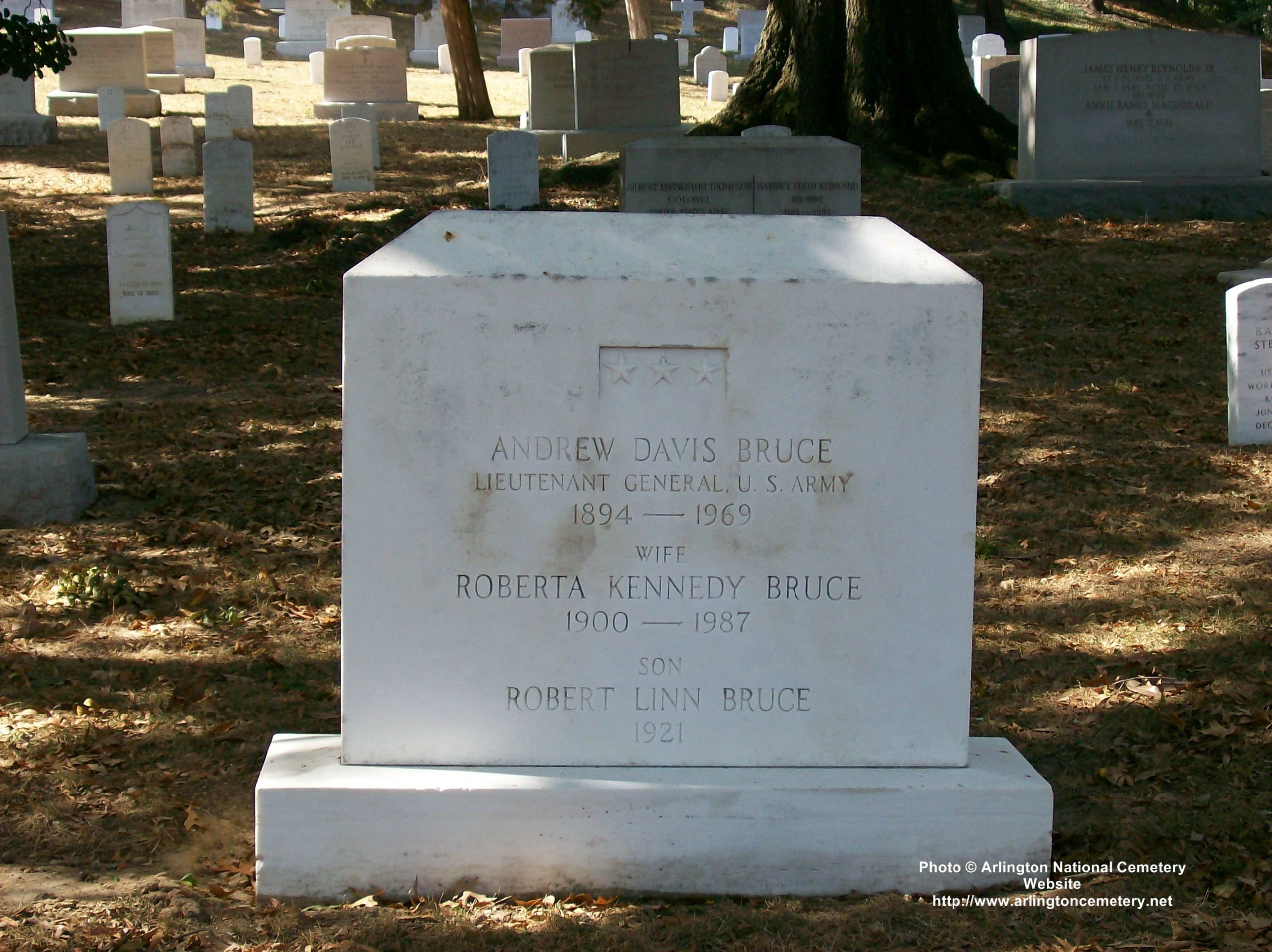Andrew Davis Bruce received a Bachelor of Science degree from Texas A & M University in 1916. In June 1917, he entered the Army as a Second Lieutenant while serving in the First Officers Training Camp at Leon Spring, Texas.
In World War I he served in all ranks to Lieutenant Colonel (temporary), in all actions of the 2nd Division near Verdun, Chateau Thierry, Soissons, Nancy, San Mihiel, Blanc Mont, and the Muese-Argonne in France and in the Army of Occupation in Germany.
After World War I, the General instructed at The Infantry School, served in the Infantry Board, served foreign duty in Panama and later was professor of Military Science and Tactics at Allen Academy in Bryan, Texas. Bruce served on the War Department General Staff involving the revision of textbooks on doctrine, the development of modern instructional aids, the revision of extension courses and the initiation of a section on Research and Development at Army War College. During this time General Bruce attended The Infantry School, the Field Artillery School, the Command and General Staff College, the Army War College, and the Naval War College. In 1941, he organized, built, and administered the Tank Destroyer Center at Fort Hood, Texas. This Center included the Tank Destroyer School, the Tank Destroyer Board, the Tank Destroyer Basic Unit Training Center, the Tank Destroyer Advanced Unit Training Center, the Tank Destroyer Training Brigade, and the Tank Destroyer Replacement Training Center. While there he introduced several methods of instruction in training later adopted by the entire Army.
A. D. Bruce became a Major General on September 9, 1942. In May 1943, he assumed command of the 77th Infantry Division which fought in the Guam Operation. Later he served as the first Governor of Hokkaido, Japan, while the Division occupied this island. In 1946, he took command of the 7th Division in the Occupation Forces of Korea.
In October 1947, he became Deputy Army Commander of the Fourth Army at Fort Sam Houston, Texas, primarily engaged in the vast training activities of five states in ROTC, National Guard, and Organized Reserve Corps.
On July 6, 1951, he became Commandant (President) of the Armed Forces Staff College at Norfolk, Virginia, and was promoted to the rank of Lieutenant General on July 30, 1951. This institution conducts the joint education of selected senior officers of the Army, Navy, Air Force, and Marine Corps. He completes his duty at this College on June 30, 1954, and retired from the army on July 31, 1954.
His decorations include Distinguished Service Cross, Distinguished Service Medal with Oak Leaf Cluster, Navy Distinguished Service Medal Legion of Merit, Bronze Star, Air Medal, Commendation Ribbon, Purple Heart, and many service ribbons. In World War I he received the Legion of Honor, three Croix de Guerre, Individual Fourragere from France; and in World War II received the Philippine Legion of Honor, the Philippine Liberation Medal, and the Presidential Unit Citation from the Philippine Government.
August 31, 1954, A. D. Bruce retired as a Lieutenant General from the U.S. Army.
A. D. Bruce, U. S. Army Lieutenant General, Retired, took office as President of the University of Houston on September 1, 1954. In December 1956, he became Chancellor of the institution.
Andrew Davis Bruce, officer in the United States Army and chief administrator of the University of Houston, the son of John Logan and Martha Washington (Smith) Bruce, was born in St. Louis, Missouri, on September 14, 1894, and grew up in Texas.
He graduated from the Agricultural and Mechanical College of Texas (now Texas A&M University), which awarded him a doctorate of laws, and in 1917 entered the army. He returned from combat duty in France in 1918 as a Lieutenant Colonel after action with the Second Division in France and service with occupation forces in Germany.
He married Roberta Linnell Kennedy in 1920 and taught military science and tactics at Allen Academy in Bryan. The couple had three children.
Between the wars Bruce did tours of duty at the Infantry School, foreign duty in Panama, historical work at the Army War College, and service on the War Department general staff, where he revised textbooks on military doctrine.
In the early 1940s he organized and commanded the Tank Destroyer Center at Fort Hood. In 1943 he assumed command of the Seventy-seventh Infantry, which he led through heavy fighting in the Guam, Leyte, and Ryukyu campaigns. He and his men buried war correspondent Ernie Pyle on Ie Shima, Ryukyu Islands, in 1945.
After Japan surrendered, Bruce served as military governor of Hokkaido. In 1947 he returned to the United States, where he filled various staff positions. He later commanded the Seventh Division in Korea. Bruce, who received medals and decorations for his service from both the United States and other governments, retired in 1954 to serve as president of the University of Houston.
The university became state-supported during his term of office, and in 1956 he was made its first chancellor. He was a Mason and a Shriner and served as president of the Houston Chamber of Commerce. Bruce Memorial Hall, a housing complex at Fort Hood, is named in his honor. He died on July 28, 1969, and was buried at Arlington National Cemetery.
BRUCE, ANDREW D.
Major, U.S. Army
San Antonio, Texas
4th Machine-Gun Battalion, 2d Division, A.E.F.
Date of Action: July 17 – 18 & October 3 – 4, `9`8
General Orders No. 44, W.D., 1919
Citation:
The Distinguished Service Cross is presented to Andrew D. Bruce, Major, U.S. Army, for extraordinary heroism in action near Vierzy, France, July 17 – 18, 1918, and near Blanc Mont October 3 – 4, 1918.
On the night of July 17-18, Major Bruce made a personal reconnaissance ahead of his troops through heavy flanking machine-gun fire. He pushed forward to the outpost lines through heavy artillery and machine-gun fire to keep in touch with all his company. On October 3-4 he made a personal reconnaissance on the left flank of his division through heavy shell fire and continual sniping and gained information which enabled him to well place his battalion and cover an exposed flank.
BRUCE, ANDREW D
- United States Army
- DATE OF BIRTH: 09/14/1894
- DATE OF DEATH: 07/27/1969
- BURIED AT: SECTION 3 SITE 4271
ARLINGTON NATIONAL CEMETERY
BRUCE, ROBERTA K
- DATE OF BIRTH: 01/12/1900
- DATE OF DEATH: 03/01/1987
- BURIED AT: SECTION 3 SITE 4271
ARLINGTON NATIONAL CEMETERY
BRUCE, ROBERT LINN
- DATE OF DEATH: 07/27/1921
- BURIED AT: SECTION 3 SITE 4271-CL
ARLINGTON NATIONAL CEMETERY
SON (MINOR CHILD) OF AD BRUCE, INFANTRY
Michael Robert Patterson was born in Arlington and is the son of a former officer of the US Army. So it was no wonder that sooner or later his interests drew him to American history and especially to American military history. Many of his articles can be found on renowned portals like the New York Times, Washingtonpost or Wikipedia.
Reviewed by: Michael Howard


